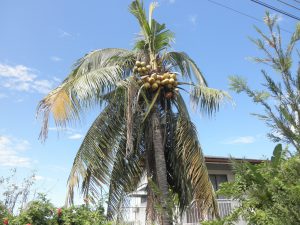Getting a taste of the tropics

Some things that come to mind when thinking of a coconut tree is the tropics where there are beautiful beaches, miles, and miles of white sand, blue skies, resting in peace and tranquility going for a swim in nice crystal clear waters being greeted by the marine life, sun tanning or resting in the shade enjoying a cool drink of sweet coconut water while listening as the waves gently clashes against the rocks or comes to the shoreline and then returns to the ocean. What a great way to sit back and enjoy all that nature has to offer.
I live in Nassau which is the capital of the Bahamas and have enjoyed many days of taking full advantage of this island lifestyle that is so great being revived and energize which is pretty amazing.
Many tourists from around the world travel to these islands for this wonderful experience along with enjoying the culture and treating themselves to our famous coconut water which is so mouthwatering. But how are coconut trees grown and cared for? I am so happy that you asked.
In this article we will be looking at this process, also a few links have been provided for you with additional information on the benefits of including coconut in your diet that has proved to work wonders along with our world-famous coconut oil.
How To Plant A Coconut Tree
- Start with a coconut that is healthy, which still has the husk, and when shaken the sound of water can be heard
- Let the coconut soak for about 2-3 days in a bucket of water
- Remove coconut from the bucket and place it in a container with well-drain soil. The container should be 12 inches deep to allow roots to grow freely
- The top or pointed part of the coconut should be placed down in the potting soil with 0ne third of the coconut above the potting soil
- Place the container in a sunny location
- Keep the soil moist but not waterlogged. In other words, don’t overwater
- In about 3-6 months you will see signs of your coconut that has germinated
- Continue to keep the soil moist not waterlogged
- As the plant begins to mature fertilize with a fertilizer that provides magnesium, boron, and manganese
- After another month or two remove the coconut from the container
- Look for a sunny location that has a lot of room for your coconut plant to grow
- The planting hole should be 2 times that of the width of the coconut
- Add organic matter to the planting hole along with soil from the container that the coconut grew in
- Continue to water as need ensuring that soil is most.
- Fertilizer coconut palm 4-5 times per year
Foliar feeding
A great way to feed or supply your coconut palm with much-needed nutrients is by a process known as foliar feeding which has proven to be effective. For more on how this is done continue reading on foliar feeding.
How To Plant A Coconut Tree
Coconut palms are slow growers and may take up to 6- 10 years to reach maturity. For quicker results, it would be good to purchase a tree that has already reached maturity and follow steps as mention earlier for proper installation also have a look at tree transplanting.
Diseases of coconuts

Fusarium wilt causes the fronds ( leaves ) to wilt and as it progresses the coconut plant will die if not treated. Brown vascular tissues appear at the base of the petiole along with brown streaks.
Treat coconut palm with a copper fungicide, ensure that pruning tools are well sanitized. Also, it is good to have your extension office have a look to further advise you on what to do.
Ganoderma butt rot affects the older fronds with signs of fronds turning yellow, wilting, and then death sets in. Infections start from the trunk wound where the fungus has access so be careful in keeping the trunk wound free.
Lethal bole rot is caused by a fungus with signs of wilting and yellowing of the older leaves. The bole tissues take on a brown to reddish appearance. As the disease spreads death of the root system sets in.
Keeping the area clean around the coconut tree will go a long way in helping your palm to stay healthy. If the tree is infected destroy it and treat the area before replanting.
Insects pest of coconut palms
Coconut palms have their share of insect pests that can cause injury, therefore, measures must be taken to ensure the overall health of your coconut palm. Here are some insects to be on the lookout for.
Mealybugs, mites, and scale insects have piercing-sucking mouthparts that cause injury by sucking the sap from coconut palms. For more on identification and control of these insects click on links Insect pest and Garden pest and pest control.
Word of caution: When using fertilizers as well as chemicals only use products that are labeled for coconut palm and follow as directed because the label is the law.
Harvest coconuts
Now comes the fun part and that is harvest time. When a coconut is brown, dark green, or orange this is another indication that the coconut is ready to pick. If coconut is light green in color it is not ready to harvest.
Use of coconuts

Here are some ways in which coconuts are used.
- The shell and the husk are used for souvenirs
- The shell and the husk are used in the planting of orchids and bromeliads attaching them to trees within the landscapes
- The coconut water can be drunk from the shell or placed in a container and freeze
- The pulp or the meat can be eaten from the shell when it is soft which is known as jelly coconut or allowing the pulp to harden and used in many yummy pastries like coconut tart which the islanders love
- Then there is coconut milk that can really give your rice such an amazing flavor
- The husk is used to make rope
- Is popular in making floor mats
- Is said to be used in bio-diesel
- Coconut oil is used in sunscreen
- Soaps
- Lotions
- Hair products
- Coconut husk is used to produce brushes and scrubbers
These are just a few of the many ways coconuts are used.
The final word
So go ahead and plant, care for, and grow your very own coconut tree and receive the many benefits of this tropical plant that is enjoyed by many around the world. Plant a coconut tree and get a taste of the tropics.
About the author
Norman loves being in the garden, both at home and for his job....
he is 'Natures Little helper' being outdoors, growing his vegetables and flowers from an early age.
Now having spent over 22 years in the profession he want to give some of his knowledge to others...
his vast array of hints and tips you will find scattered over this site will help you no end growing plants in your garden.

I have never known how to plant or grow a coconut tree. There are a lot of details that are involved in fertilizing the tree after you get it going. Thank you so much for taking the time to share this information with us. I love the face and hat picture that was done with the coconut.
Keep up the good work.
Hello Lynn so good to see you and so Happy I could help. These trees are amazing and the benefits are wonderful for what they can do for us. Thanks and all the best to you.
Hi Norman, sounds like you living in a dream location. I used to go to Thailand quite a lot and my first drink was always a fresh coconut. Is it true that the army used them as blood substitute way back in the days? Because they are so similar to our human DNA?
Or did I just fall for a silly rumour? Anyway, it sounds like quite a process to grow a tree from the nut and they need a lot of water by the sound of it. Unfortunately, I do not live in the tropics anymore otherwise I would have loved to grow my own coconut trees.
But you never know where I might end up one day, the world is your coconut, I mean oyster. 🙂 Thanks
Hello so good to meet you, coconuts are pretty amazing and yes I do live in a beautiful place. Who knows one day Gods will you my be here. As for that story of the army will have to research that. Thanks again all the best of success to you and have a good day.